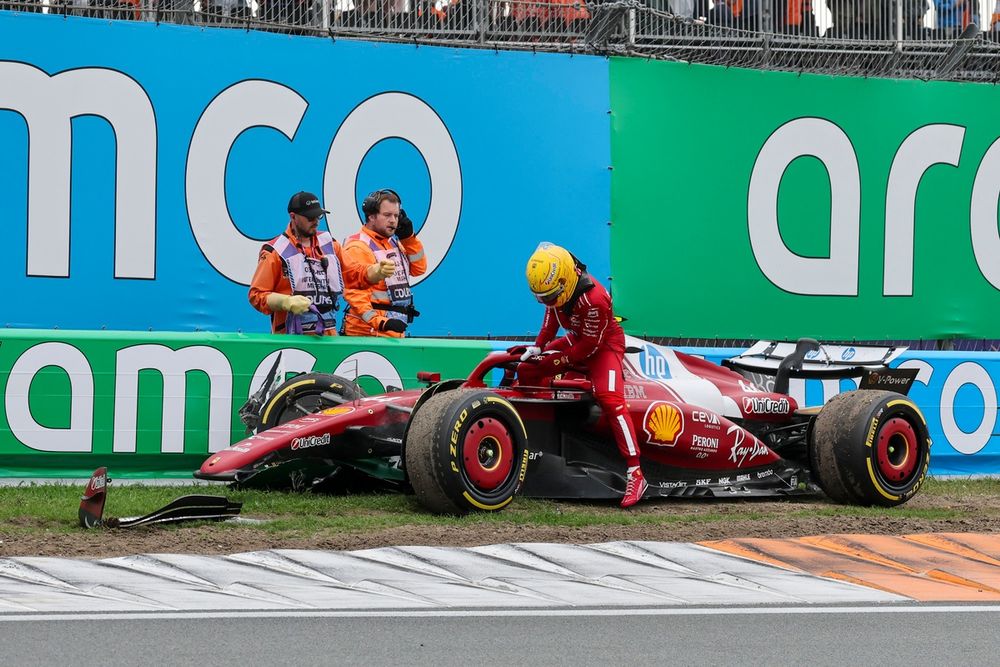There’s nothing unusual in drivers messing up the pre-race routine and getting punished for that.
Lewis Hamilton himself picked up two penalties in Sochi, 2020 for misinterpreting then-race director Michael Masi’s instructions on practice starts, performing them in a place which the stewards deemed inappropriate – and therefore had to serve two five-second penalties during the race.
There have been more examples like that in recent years, which makes Hamilton’s Sunday penalty particular in the sense that the stewards only announced their decision after the race.
What did Hamilton do wrong?
Essentially, Hamilton was penalised for going too fast during his reconnaissance laps – particularly in the last corner, the banked section leading to the starting grid. Due to the nature of the track, before the event the race director Rui Marques informed drivers – and teams via his official notes, issued ahead of each weekend – that during the pre-race procedures the light panel 18, located next to the exit of the last corner, would be showing a double-yellow signal. That meant drivers needed to slow down significantly and be ready to stop, as the rules specify.
According to the stewards’ decision document, Hamilton did reduce his speed by around 20kph compared to practice laps – but that wasn’t considered enough. Additionally, he was found in breach of Article 44.1, which “requires all drivers covering more than one reconnaissance lap to drive down the pit entry road” at “greatly reduced speed”.
The stewards noted Hamilton reduced his throttle application by only 10–20% and braked 70 metres earlier – which they judged as not sufficient.
Lewis Hamilton, Ferrari
Photo by: John Thys / AFP via Getty Images
Yet these incidents occurred more than half an hour before the start – and in theory, there was time to make a decision. Had that happened, Hamilton would most likely have received a 10-second stop-and-go penalty, which is the sanction recommended in the penalty guidelines that the FIA made public earlier this year for transparency.
That penalty is exactly what is “prescribed” for drivers ignoring double-yellow flag signals – which was the very offence Hamilton was investigated for, even if it happened during the pre-race procedure.
Why was the penalty not immediate?
The intriguing question is why the stewards waited until after the race to make their ruling.
In their official document, the stewards in Zandvoort – Nish Shetty, Matthew Selley, Natalie Corsmit and former F1 driver Pedro Lamy – explained: “We looked through the available telemetry within the FIA system. We also requested the team to provide us with their telemetry data. All of this took some time and this decision was delayed as a result.”
It appears the stewards simply didn’t have enough information at the time – and Ferrari’s communication contradicted the FIA’s initial data.
So, instead of issuing Hamilton a 10-second stop-and-go penalty, which would have had to be served shortly after the race start and would have ended any chance of a result, they decided to wait until after the grand prix to hear from the team engineers and examine their data.

Lewis Hamilton, Ferrari crash
Photo by: Gabriele Lanzo / Alessio Morgese / NurPhoto via Getty Images
Ferrari was summoned at 17:05 local time, about half an hour after the chequered flag. Only then did the stewards feel they had enough information to make their decision. Instead of applying the full penalty, they considered “mitigating circumstances” – namely, that Hamilton did slow down, even if not enough.
Normally, when a driver cannot serve a stop-and-go, it is converted into a 10-place grid drop, according to the same FIA guidelines. But in this case the stewards reduced it to five places. Hamilton also received “only” two penalty points on his licence, instead of the usual three for such an offence.
The downside of the delayed decision is clear: had Hamilton been given the penalty during the race at Zandvoort, it would not have changed his result. Now, however, his Monza weekend – his first with Ferrari – will be compromised.
In this article
Be the first to know and subscribe for real-time news email updates on these topics

